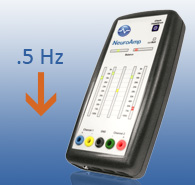Archive for the ‘Uncategorized’ Category
Friday, October 31st, 2008
 Over the last several years we have increasingly explored the low-frequency domain of the EEG for neurofeedback applications. Surprisingly to us all this has led us to the realm of infra-low frequency training, below the 0.5 Hz cutoff that is commonplace in EEG work. It is tempting to refer to this very low frequency neurofeedback as a breakthrough, but in fact this has simply been the latest iteration of a long progression from one milestone to the next in an evolution of our particular protocol-based approach. So it does not feel like a breakthrough to those who have been involved every step of the way. It only appears like a breakthrough because when considered on its own it seems like a complete negation of the standard assumptions of neurofeedback. Perhaps in consequence of that the method has already attracted the usual gallery of skeptics. The survival of this kind of skepticism at this late date reminds us that the typical understanding people have about neurofeedback is being grossly violated. A reappraisal of the usual assumptions is therefore in order. Over the last several years we have increasingly explored the low-frequency domain of the EEG for neurofeedback applications. Surprisingly to us all this has led us to the realm of infra-low frequency training, below the 0.5 Hz cutoff that is commonplace in EEG work. It is tempting to refer to this very low frequency neurofeedback as a breakthrough, but in fact this has simply been the latest iteration of a long progression from one milestone to the next in an evolution of our particular protocol-based approach. So it does not feel like a breakthrough to those who have been involved every step of the way. It only appears like a breakthrough because when considered on its own it seems like a complete negation of the standard assumptions of neurofeedback. Perhaps in consequence of that the method has already attracted the usual gallery of skeptics. The survival of this kind of skepticism at this late date reminds us that the typical understanding people have about neurofeedback is being grossly violated. A reappraisal of the usual assumptions is therefore in order.
First of all, at the low frequencies extending down to 0.01 Hz it is no longer clear whether we are just seeing EEG phenomenology or whether the signal is dominated by other physiological variables. Clinically of course it does not matter as long as the brain responds to our reinforcements, but it matters a great deal to our understanding. Secondly the issue has been raised as to whether we are seeing a valid signal at these low frequencies. It turns out that the signal we are tracking is not small at all. In fact, in typical EEG measurements the very low frequencies are eliminated by filtering just so they won’t get in the way of what we are trying to do. If the low frequencies had been left in the signal the early researchers would have been watching the EEG bouncing wildly up and down on the oscilloscope screen, which would have been quite a nuisance. The conventional EEG signal we have been looking at just sits on top of much larger undulations at the lower frequencies, much like foam on an ocean wave. (more…)
Posted in Uncategorized | No Comments »
Wednesday, October 29th, 2008
 Sometimes I still think back to the awesome precision exhibited by the Chinese drummers during the opening ceremony of the Olympics, along with the synchrony and cohesion of the dancers, the choreographed wave phenomena, etc. Among other things it was a demonstration of the timing precision of which our nervous systems are capable. And at many levels it was a demonstration of the power of the collective. Sometimes I still think back to the awesome precision exhibited by the Chinese drummers during the opening ceremony of the Olympics, along with the synchrony and cohesion of the dancers, the choreographed wave phenomena, etc. Among other things it was a demonstration of the timing precision of which our nervous systems are capable. And at many levels it was a demonstration of the power of the collective.
Soon after the Olympics David Brooks was moved to write an editorial on the same topic. In the West we tend to give priority to individual effort, whereas in the East we are seeing the rise of economic power among people with a much stronger social impulse. Their success makes the issue much more trenchant for us all. At the same time scientists are weighing in the issue, with the finding that our sense of individuality may to a large extent be illusory. We are much more strongly subject to social influences than we are aware. (more…)
Posted in Uncategorized | No Comments »
Thursday, October 23rd, 2008
 An independent film company known as Digg Site Productions recently began filming on a neurofeedback documentary to help bring attention to this industry. The Digg Site film crew has already captured several prominent sports figures who have openly talked about the benefits of neurofeedback and how it has impacted their sports performance. This important documentary will also key in on specialists in spect imaging and q-EEG, along with neurofeedback clinicians and independent voices from outside the field. An independent film company known as Digg Site Productions recently began filming on a neurofeedback documentary to help bring attention to this industry. The Digg Site film crew has already captured several prominent sports figures who have openly talked about the benefits of neurofeedback and how it has impacted their sports performance. This important documentary will also key in on specialists in spect imaging and q-EEG, along with neurofeedback clinicians and independent voices from outside the field.
This entire documentary project is all being funded privately and personally by the staff at Digg Site who have personal reasons to make this documentary and fund this from their own personal bank accounts. But they cannot do it alone. Here at EEG Info we have pledged $1,000 to help make this documentary possible. Please consider making a contribution. The Donate button below will take you to a paypal page where you can donate $25, or you can use paypal to send any amount you like to the paypal account stacyheatherly@cox.net – or send an e-mail to that address for other payment options.
Digg Site Productions needs your help to make this documentary possible! Funding for this documentary is not available from the big networks and media companies. Think about the impact that this documentary could have. If this aires on HBO, the discovery channel, or other cable networks, the exposure for our field and the effect for your practice could be tremendous. A simple donation of $25 could help make this documentary possible, and the return to you in exposure for this field, and good positive information circulating in the popular media, would be worth far more than this small contribution.
Please consider donating $25 or more. Thank you.

Kurt Othmer
Posted in Uncategorized | No Comments »
Tuesday, August 5th, 2008
 So pronounces the headline in the Los Angeles Times. Needed are allied health professionals, those of lesser credentials who nevertheless are crucial to the medical enterprise. Involved here are some two hundred occupations ranging from respiratory care practitioners to radiographers to paper pushers. These allied professionals make up some 60% of the labor pool in the health care system. The greatest projected need appears to be among pharmacy techs, dental hygienists, and physical therapy assistants. So pronounces the headline in the Los Angeles Times. Needed are allied health professionals, those of lesser credentials who nevertheless are crucial to the medical enterprise. Involved here are some two hundred occupations ranging from respiratory care practitioners to radiographers to paper pushers. These allied professionals make up some 60% of the labor pool in the health care system. The greatest projected need appears to be among pharmacy techs, dental hygienists, and physical therapy assistants.
The author obviously doesn’t know about neurofeedback yet. It is worth remarking that in our experience we are taking part in the growth curve of health care rather than being caught up in the impending recession. Neurofeedback clinics are busier than ever before. Inquiries are ramping up. The services we offer are not optional for many people, and that factor will dominate in our growth as skepticism regarding neurofeedback is increasingly discredited. More professionals are moving from mere curiosity to active involvement with neurofeedback.
In various ways neurofeedback is appearing on the scene as a “just-in-time” modality. Our society will undergo enormous stresses in coming years as the hangover from our orgy of fiscal excess is overcome. The growing problem of mental dysfunction in the elderly combines with burgeoning issue of educational failure among the young to present a significant challenge to our society for which the neuromodulation technologies in general, and neurofeedback in particular, present the only viable remedy currently available. And in the middle age range we have the returning veterans and the generally stressed-out middle class, for whom neurofeedback also presents a reprieve. (more…)
Posted in Uncategorized | No Comments »
Thursday, July 31st, 2008
Two powerful individuals are combining their efforts and resources in a renewed campaign against the scourge of tobacco: Bill Gates and Michael Bloomberg, mayor of New York City. Despite best efforts to date to change behavior, about one billion people still smoke; half die prematurely from smoking-related causes; and the typical loss of life expectancy ranges from ten to fifteen years (The Economist, July 26th issue, p. 70). Ironically, Philip Morris had it right when they made the case in the Czech Republic years ago that smoking actually reduced the costs of providing social security because it conveniently caused people to die sooner.
What may make the difference this time, suggests the Economist newspaper, is that Gates and Bloomberg come with money, methods, and motivation. When it comes to methods, however, the plan is to be receptive to a wide variety of initiatives that have promise rather than funneling efforts into a pre-ordained program. That offers an opening for neurofeedback.
Neurofeedback has something unique to offer when it comes to smoking. As we have said for some years now, it is a mistake to campaign against smoking merely because of the long-term impacts when there are so many obvious near-term benefits. The human operating system responds much more effectively to short-term rewards than to vague long-term disincentives. Willpower is enormously over-rated when it comes to fighting a reward system that is largely mechanized subconsciously. (more…)
Posted in Uncategorized | 1 Comment »
Thursday, July 31st, 2008

The Lupus Foundation is one of a number of organizations concerned about the phase-out of incandescent light bulbs in favor of compact fluorescents (CFLs) in the wake of the Energy Independence and Security Act of 2007 that mandates higher lighting efficiency to be met by 2012-14. The new standard is a conversion efficiency of 70%.
The concern, apparently, is that UVB radiation from CFLs may cause photosensitivity in people with lupus and other conditions. Other organizations that are concerned about this issue include Sjogren’s Syndrome Foundation, National Psoriasis Foundation, and the Epilepsy Foundation.
I believe this concern to be misguided. The problem most likely relates to the frequency characteristics of the fluorescent illumination, not to the UVB radiation. The effects, after all, can be turned on and off with the lights, which places suspicion on the direct effects of the modulated signal on our brain activity. Any supposed physiological effect of the UVB radiation would be expected to persist. (more…)
Posted in Uncategorized | 5 Comments »
|
|
Subscribe to Email Newsletter
The EEG Info Newsletter circulates via email at least once a month. A variety of topics related to the Neurofeedback / EEG Biofeedback field are covered in over 200 articles.
|
 Over the last several years we have increasingly explored the low-frequency domain of the EEG for neurofeedback applications. Surprisingly to us all this has led us to the realm of infra-low frequency training, below the 0.5 Hz cutoff that is commonplace in EEG work. It is tempting to refer to this very low frequency neurofeedback as a breakthrough, but in fact this has simply been the latest iteration of a long progression from one milestone to the next in an evolution of our particular protocol-based approach. So it does not feel like a breakthrough to those who have been involved every step of the way. It only appears like a breakthrough because when considered on its own it seems like a complete negation of the standard assumptions of neurofeedback. Perhaps in consequence of that the method has already attracted the usual gallery of skeptics. The survival of this kind of skepticism at this late date reminds us that the typical understanding people have about neurofeedback is being grossly violated. A reappraisal of the usual assumptions is therefore in order.
Over the last several years we have increasingly explored the low-frequency domain of the EEG for neurofeedback applications. Surprisingly to us all this has led us to the realm of infra-low frequency training, below the 0.5 Hz cutoff that is commonplace in EEG work. It is tempting to refer to this very low frequency neurofeedback as a breakthrough, but in fact this has simply been the latest iteration of a long progression from one milestone to the next in an evolution of our particular protocol-based approach. So it does not feel like a breakthrough to those who have been involved every step of the way. It only appears like a breakthrough because when considered on its own it seems like a complete negation of the standard assumptions of neurofeedback. Perhaps in consequence of that the method has already attracted the usual gallery of skeptics. The survival of this kind of skepticism at this late date reminds us that the typical understanding people have about neurofeedback is being grossly violated. A reappraisal of the usual assumptions is therefore in order.
 Sometimes I still think back to the awesome precision exhibited by the Chinese drummers during the opening ceremony of the Olympics, along with the synchrony and cohesion of the dancers, the choreographed wave phenomena, etc. Among other things it was a demonstration of the timing precision of which our nervous systems are capable. And at many levels it was a demonstration of the power of the collective.
Sometimes I still think back to the awesome precision exhibited by the Chinese drummers during the opening ceremony of the Olympics, along with the synchrony and cohesion of the dancers, the choreographed wave phenomena, etc. Among other things it was a demonstration of the timing precision of which our nervous systems are capable. And at many levels it was a demonstration of the power of the collective.  An independent film company known as Digg Site Productions recently began filming on a neurofeedback documentary to help bring attention to this industry. The Digg Site film crew has already captured several prominent sports figures who have openly talked about the benefits of neurofeedback and how it has impacted their sports performance. This important documentary will also key in on specialists in spect imaging and q-EEG, along with neurofeedback clinicians and independent voices from outside the field.
An independent film company known as Digg Site Productions recently began filming on a neurofeedback documentary to help bring attention to this industry. The Digg Site film crew has already captured several prominent sports figures who have openly talked about the benefits of neurofeedback and how it has impacted their sports performance. This important documentary will also key in on specialists in spect imaging and q-EEG, along with neurofeedback clinicians and independent voices from outside the field. So pronounces the headline in the Los Angeles Times. Needed are allied health professionals, those of lesser credentials who nevertheless are crucial to the medical enterprise. Involved here are some two hundred occupations ranging from respiratory care practitioners to radiographers to paper pushers. These allied professionals make up some 60% of the labor pool in the health care system. The greatest projected need appears to be among pharmacy techs, dental hygienists, and physical therapy assistants.
So pronounces the headline in the Los Angeles Times. Needed are allied health professionals, those of lesser credentials who nevertheless are crucial to the medical enterprise. Involved here are some two hundred occupations ranging from respiratory care practitioners to radiographers to paper pushers. These allied professionals make up some 60% of the labor pool in the health care system. The greatest projected need appears to be among pharmacy techs, dental hygienists, and physical therapy assistants.